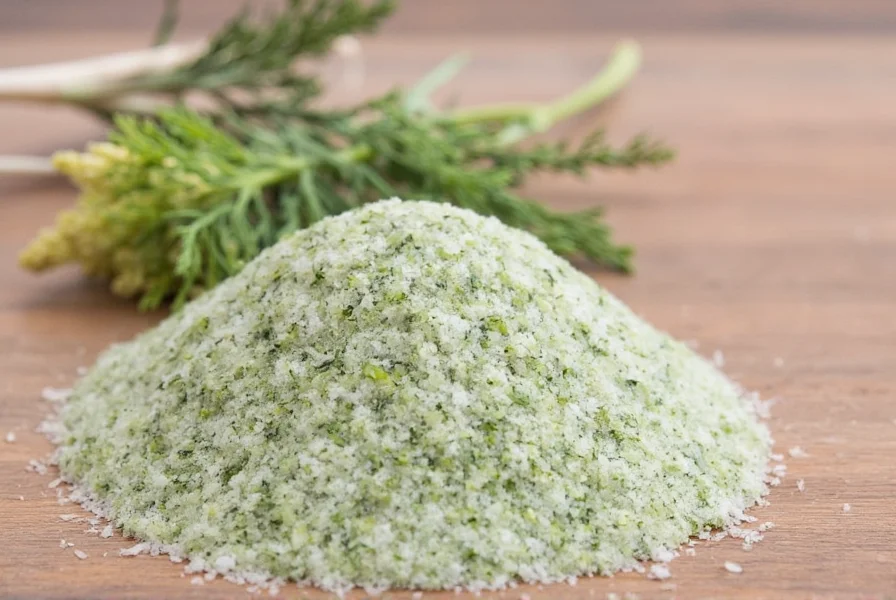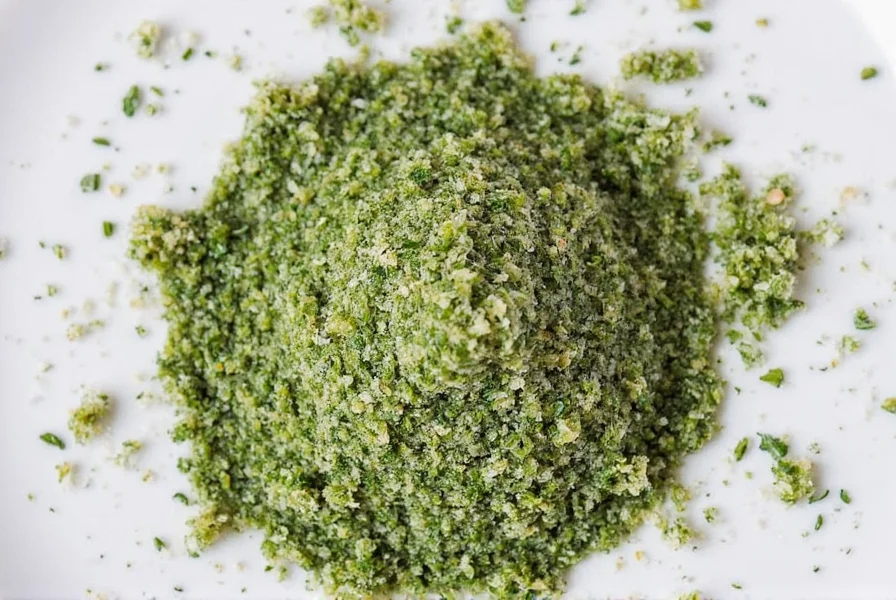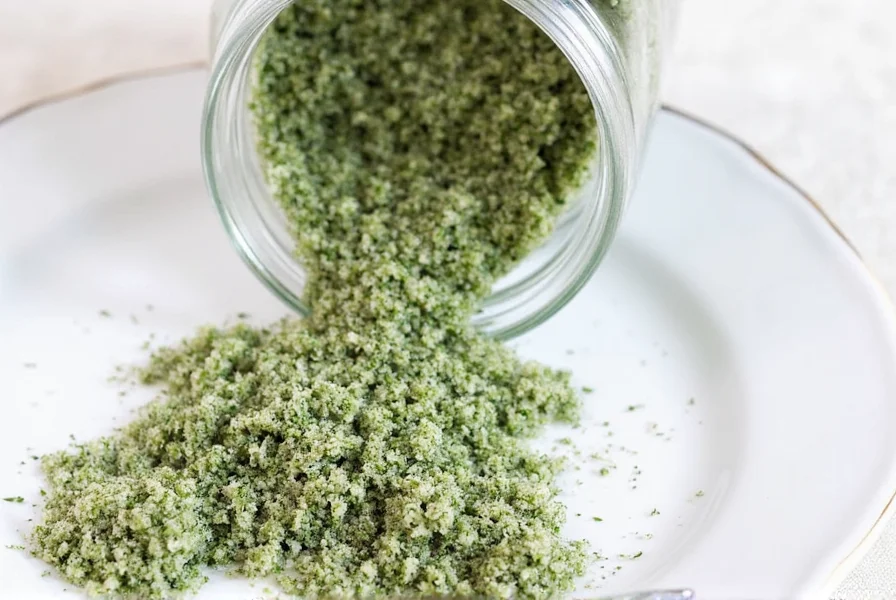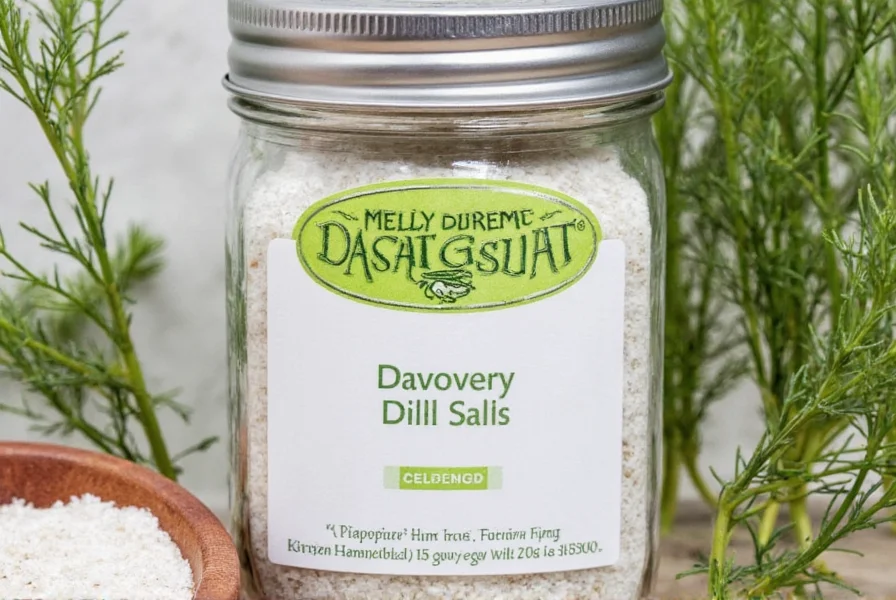Table of Contents
What Is Dill Salt?
Dill salt is a specialty seasoning blend made by combining high-quality sea salt with dried dill weed. Unlike regular table salt, which provides only sodium flavor, dill salt delivers a distinctive fresh, grassy, and slightly citrusy taste that enhances dishes without overpowering them. This versatile seasoning is commonly used as a finishing salt to preserve its delicate flavor profile.
According to culinary experts, dill salt was traditionally developed in Scandinavian and Eastern European cuisines to complement fish and vegetables. Modern chefs use it to add complexity to simple dishes while reducing overall sodium intake since less is needed to achieve desired flavor.

How to Use Dill Salt
For optimal results, use dill salt as a finishing touch rather than during cooking. Its delicate flavor compounds break down with prolonged heat exposure. Here are specific applications for different dishes:
- Grilled Salmon: Sprinkle 1/4 teaspoon per serving over salmon just before serving. The salt complements the fish's natural oils while adding aromatic notes.
- Roasted Potatoes: Toss cooked potatoes with 1/2 teaspoon dill salt per cup of potatoes for enhanced flavor without extra fat.
- Summer Salads: Mix 1/8 teaspoon per serving into cucumber-tomato salads for a refreshing twist.
- Butter Spread: Blend 1 tablespoon dill salt into 1/2 cup softened butter for a quick, flavorful topping for bread or corn.
- Avocado Toast: Sprinkle lightly over avocado toast with lemon juice for a gourmet breakfast option.
Professional chefs recommend using dill salt sparingly - start with half the amount of regular salt you'd normally use, then adjust to taste. Its concentrated flavor means you'll need less than traditional salt to achieve the same savory impact.

Top Dill Salt Recipes
These specific recipes showcase dill salt's versatility:
1. Lemon-Dill Salt Roasted Vegetables
Ingredients: 2 cups chopped vegetables (carrots, zucchini, bell peppers), 1 tablespoon olive oil, 1 teaspoon lemon zest, 1/2 teaspoon dill salt
Method: Toss vegetables with olive oil and lemon zest. Roast at 400°F for 25 minutes. Immediately after removing from oven, sprinkle with dill salt for maximum flavor impact.
2. Dill Salt Cream Cheese Spread
Ingredients: 8 oz cream cheese, 1 tablespoon fresh dill (optional), 1/2 teaspoon dill salt, 1 teaspoon lemon juice
Method: Beat cream cheese until smooth. Fold in dill salt, lemon juice, and fresh dill. Chill for 1 hour before serving with bagels or crackers.
3. Dill Salt Lemon Chicken
Ingredients: 4 chicken breasts, 2 tablespoons olive oil, 1 teaspoon dill salt, 1 tablespoon lemon juice, 1 clove garlic (minced)
Method: Marinate chicken in olive oil, lemon juice, garlic, and dill salt for 30 minutes. Grill or bake until fully cooked. Serve immediately for best flavor.

| Feature | Dill Salt | Regular Salt |
|---|---|---|
| Flavor Profile | Herbaceous, fresh, citrusy notes | Salty, neutral |
| Sodium Content | Varies, typically 20-30% less sodium per serving due to flavor intensity | High (100% sodium content) |
| Best Use Case | Finishing salt for seafood, vegetables, salads, and light dishes | General cooking, baking, and long-cooking dishes |
| Nutritional Benefits | Contains antioxidants from dill, may support digestion | No additional nutritional benefits |
Buying Guide for Dill Salt
When purchasing dill salt, consider these key factors:
- Ingredient Quality: Look for products with dill listed as the primary ingredient after salt. Avoid those with artificial flavors or excessive additives.
- Texture: Coarse salt blends better with dill than fine table salt, preserving the herb's flavor compounds.
- Source: Sea salt-based dill salt typically has better flavor than table salt-based versions.
- Shelf Life: Properly stored dill salt maintains freshness for 6-12 months. Check expiration dates.
Top recommended brands:
- Herbivore Dill Salt: Organic sea salt with premium dried dill. Ideal for gourmet cooking and health-conscious consumers.
- Spice House Dill Salt: Crafted by professional chefs, with balanced dill-to-salt ratio for perfect flavor.
- Simply Organic Dill Salt: Certified organic option with transparent sourcing and no artificial additives.

Health Benefits of Dill Salt
While dill salt isn't a health supplement, it does offer some advantages over regular salt:
- Reduced Sodium Intake: Because of its strong flavor, you typically use less dill salt than regular salt, potentially reducing overall sodium consumption.
- Antioxidant Properties: Dill contains flavonoids and monoterpenes that act as antioxidants, helping combat oxidative stress.
- Digestive Support: Traditional medicine uses dill to soothe digestive discomfort, though scientific evidence is limited.
- Heart Health: Replacing some regular salt with dill salt may contribute to better heart health through reduced sodium intake.
According to the American Heart Association, reducing sodium intake can lower blood pressure and reduce cardiovascular risk. Using dill salt as part of a sodium reduction strategy can be beneficial, though it should not replace medical advice for those with hypertension.
Frequently Asked Questions
Can I use dill salt in baking?
Yes, but with caution. Dill salt works best in savory baked goods like bread, biscuits, or savory scones. Avoid using it in sweet baked goods as the dill flavor will clash with sugar. For savory baking, use only 1/4 to 1/2 teaspoon per recipe to avoid overpowering the dish.
Does dill salt contain iodine?
Whether dill salt contains iodine depends entirely on the base salt used. If made with iodized table salt, it will contain iodine. If made with sea salt, kosher salt, or Himalayan salt (which are typically not iodized), it won't contain iodine. Always check the product label for specific information.
How long does homemade dill salt last?
When stored properly in an airtight container away from moisture and direct sunlight, homemade dill salt maintains peak flavor for 6-8 months. After this time, the dill flavor gradually diminishes, though the salt itself remains safe to consume indefinitely.
Can I substitute dill salt for regular salt in all recipes?
No. Dill salt is best used as a finishing salt or in dishes where its flavor complements the other ingredients. It's not suitable for recipes requiring pure sodium without additional flavor, such as bread-making or certain pickling applications. For these, use regular salt and add dill separately if desired.
What's the best way to store dill salt?
Store dill salt in an airtight glass container away from heat, moisture, and direct sunlight. A cool, dark pantry is ideal. Avoid plastic containers as they can absorb odors and flavors over time. For long-term storage, consider keeping it in the refrigerator to preserve freshness.
Is dill salt gluten-free?
Yes, pure dill salt is naturally gluten-free. However, if purchasing commercial products, check for potential cross-contamination warnings if you have celiac disease or severe gluten sensitivity. Some brands process their products in facilities that also handle gluten-containing ingredients.
How much dill salt should I use for a pound of salmon?
For a 1-pound salmon fillet, use approximately 1/2 to 3/4 teaspoon of dill salt. Sprinkle evenly over the surface just before cooking or immediately after cooking for best results. Remember that dill salt is more flavorful than regular salt, so start with less and adjust to taste.
Can I make dill salt at home?
Yes, making dill salt at home is simple. Combine 1 part dried dill weed (finely crushed) with 4 parts coarse sea salt. Mix thoroughly and store in an airtight container for at least 3-5 days to allow flavors to meld. For best results, use organic dill and high-quality sea salt. Homemade dill salt typically has a more vibrant flavor than commercial versions.











 浙公网安备
33010002000092号
浙公网安备
33010002000092号 浙B2-20120091-4
浙B2-20120091-4